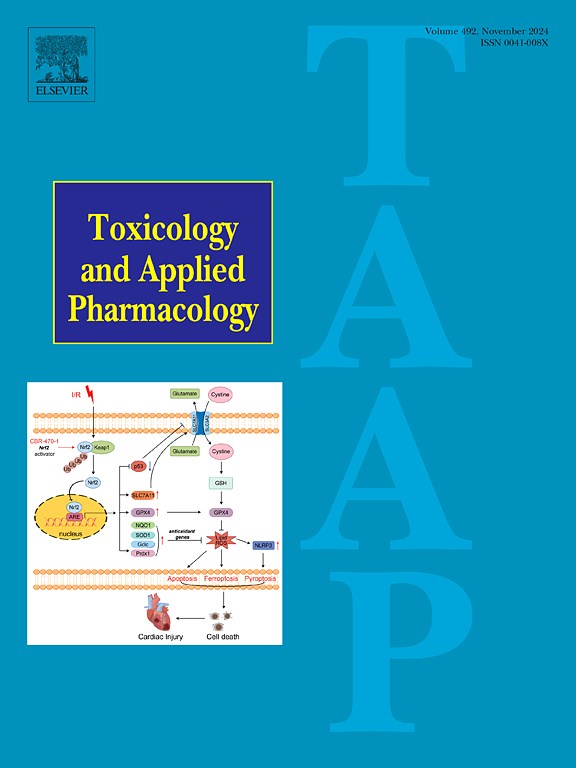Paricalcitol, an active vitamin D analog, mitigates dexamethasone-induced hepatic injury: Role of autophagy, pyroptosis, and PERK/Nrf2/HO-1 signaling pathway
IF 3.3
3区 医学
Q2 PHARMACOLOGY & PHARMACY
引用次数: 0
Abstract
Drug-induced toxicity is considered a crucial clinical affair, as some adverse effects could be severe or life threatening. Drugs may have adverse effects by altering biological pathways that aren't always involved in the drug's reaction. From this perspective, the purpose of the current study was to assess the impacts of paricalcitol, a synthetic, active, and selective vitamin D receptor activator, on dexamethasone-induced liver injury, and discover the probable implicated signaling pathways as well. Male Wistar rats were treated with paricalcitol at a dose of 0.2 μg/kg, daily, i.p for 12 days and injected with 8 mg/kg dexamethasone i.p daily over the last 6 days. Administration of paricalcitol improved liver function markers, lipid profile, reduced histopathologic changes in hepatic sections, and restored normal oxidative status. Moreover, paricalcitol markedly decreased hepatic collagen deposition as confirmed by Masson's trichrome staining. Paricalcitol effectively inhibited endoplasmic reticulum stress through decreasing expression of tissue PERK and Chop, increasing hepatic Nrf2, and HO-1 activity. Besides, paricalcitol decreased levels of NLRP3 and IL-1β as well as decreased expression of active caspase-1 p20, GSDMD-N-terminal indicating suppression of NLRP3/caspase-1/GSDMD pyroptosis pathway. Paricalcitol can protect against dexamethasone-induced liver injury showing a promising therapeutic value in drug-induced liver injuries.

Paricalcitol,一种活性维生素D类似物,减轻地塞米松诱导的肝损伤:自噬,焦亡和PERK/Nrf2/HO-1信号通路的作用。
药物引起的毒性被认为是一个重要的临床事件,因为一些不良反应可能严重或危及生命。药物可能通过改变并不总是与药物反应有关的生物途径而产生不良影响。从这个角度来看,本研究的目的是评估paricalcitol(一种合成的、活性的、选择性的维生素D受体激活剂)对地塞米松诱导的肝损伤的影响,并发现可能涉及的信号通路。雄性Wistar大鼠以0.2 μg/kg,每日,1次灌胃的剂量给予哌利醇治疗12 d,并以8 mg/kg地塞米松灌胃,持续6 d。给予特立醇可改善肝功能指标、脂质谱、减少肝切片的组织病理学改变,并恢复正常的氧化状态。此外,马松三色染色证实,白藜芦醇明显减少肝胶原沉积。Paricalcitol通过降低组织PERK和Chop的表达,增加肝脏Nrf2和HO-1活性,有效抑制内质网应激。此外,paricalcitol降低NLRP3和IL-1β水平,降低活性caspase-1 p20、GSDMD- n末端的表达,表明NLRP3/caspase-1/GSDMD焦亡途径受到抑制。Paricalcitol对地塞米松性肝损伤具有保护作用,在药物性肝损伤中具有良好的治疗价值。
本文章由计算机程序翻译,如有差异,请以英文原文为准。
求助全文
约1分钟内获得全文
求助全文
来源期刊
CiteScore
6.80
自引率
2.60%
发文量
309
审稿时长
32 days
期刊介绍:
Toxicology and Applied Pharmacology publishes original scientific research of relevance to animals or humans pertaining to the action of chemicals, drugs, or chemically-defined natural products.
Regular articles address mechanistic approaches to physiological, pharmacologic, biochemical, cellular, or molecular understanding of toxicologic/pathologic lesions and to methods used to describe these responses. Safety Science articles address outstanding state-of-the-art preclinical and human translational characterization of drug and chemical safety employing cutting-edge science. Highly significant Regulatory Safety Science articles will also be considered in this category. Papers concerned with alternatives to the use of experimental animals are encouraged.
Short articles report on high impact studies of broad interest to readers of TAAP that would benefit from rapid publication. These articles should contain no more than a combined total of four figures and tables. Authors should include in their cover letter the justification for consideration of their manuscript as a short article.

 求助内容:
求助内容: 应助结果提醒方式:
应助结果提醒方式:


